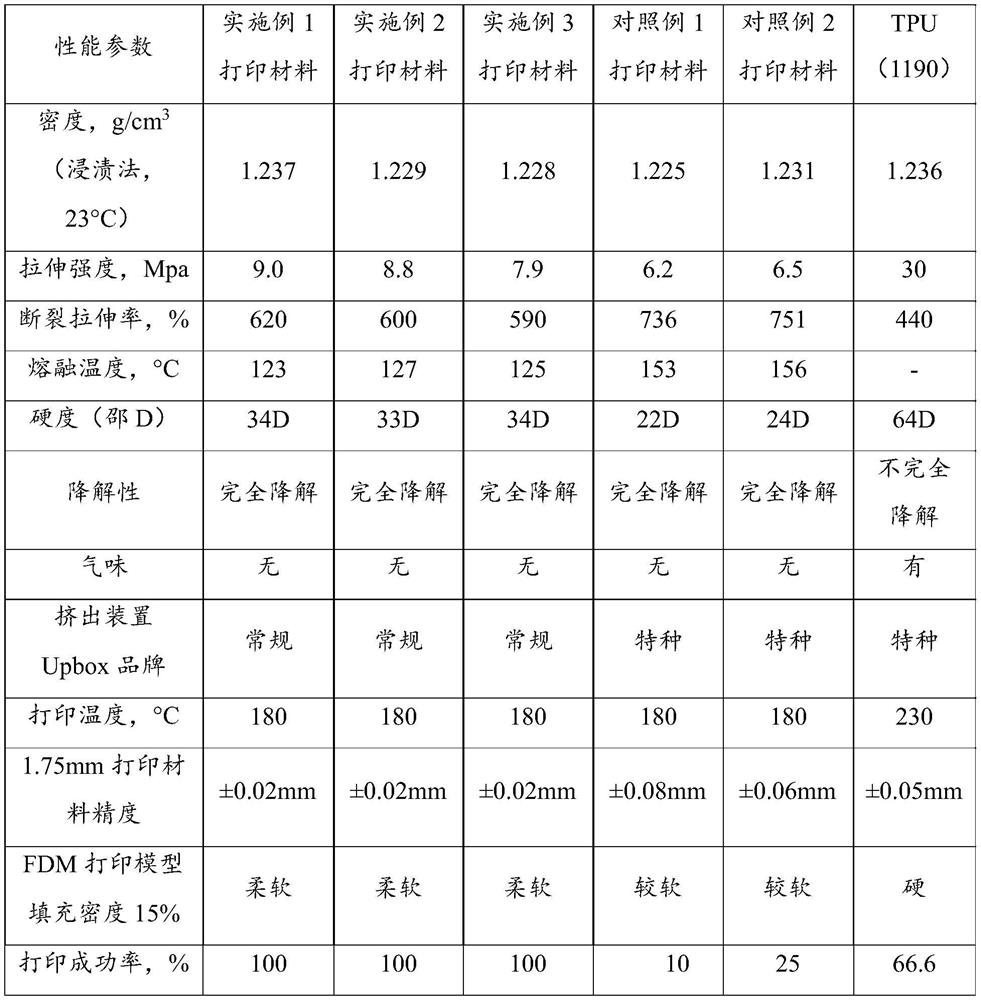Degradable flexible 3D printing material as well as preparation method and application thereof
A 3D printing and flexible technology, applied in the field of additive manufacturing, can solve the problems of material feeding into the throat, printing failure, wire jamming, etc., and achieve the effect of good flexibility, reduced thermal expansion rate, and small thermal expansion ratio
- Summary
- Abstract
- Description
- Claims
- Application Information
AI Technical Summary
Problems solved by technology
Method used
Image
Examples
Embodiment 1
[0032] The degradable flexible 3D printing material of this embodiment is made of the following raw materials in parts by weight: 70 parts of PBAT, 10 parts of polylactic acid, 6 parts of polycaprolactone, 12 parts of modified starch, and 1 part of maleic anhydride grafted polylactic acid , 4 parts of PEG20000 and 2 parts of compatibilizer; among them, modified starch is obtained by modifying corn starch with silane coupling agent KH550, and sorbitol is used as compatibilizer.
[0033] The preparation steps of the above-mentioned degradable flexible 3D printing materials are as follows:
[0034] 1. Preparation of modified starch
[0035] Mix 10 parts of cornstarch and 2 parts of silane coupling agent KH550 evenly, then stir for 20 minutes at a temperature of 50°C and a stirring speed of 150r / min; disperse the above mixture in 50 parts of absolute ethanol, Fully stir for 20 minutes under the conditions of 15° C. and 150 r / min stirring speed; finally, dry the obtained mixture t...
Embodiment 2
[0039] The degradable flexible 3D printing material of this embodiment is made of the following raw materials in parts by weight: 60 parts of PBAT, 15 parts of polylactic acid, 3 parts of polycaprolactone, 15 parts of modified starch, and 0.5 parts of maleic anhydride grafted polylactic acid , 3 parts of PEG20000 and 1 part of compatibilizer; wherein, modified starch is obtained by modifying sweet potato starch with silane coupling agent KH570, and glycerol is used as compatibilizer.
[0040] The preparation steps of the above-mentioned degradable flexible 3D printing materials are as follows:
[0041] 1. Preparation of modified starch
[0042] Mix 5 parts of sweet potato starch and 1 part of silane coupling agent KH570 evenly, then stir for 30 minutes at a temperature of 40 °C and a stirring speed of 200 r / min; disperse the above mixture in 55 parts of absolute ethanol, Fully stir for 30 minutes under the conditions of 10°C and 200r / min stirring speed; finally, dry the obtai...
Embodiment 3
[0046] The degradable flexible 3D printing material of this embodiment is made of the following raw materials in parts by weight: 80 parts of PBAT, 5 parts of polylactic acid, 8 parts of polycaprolactone, 5 parts of modified starch, and 1.5 parts of maleic anhydride grafted polylactic acid , 5 parts of PEG20000 and 3 parts of compatibilizer; wherein, modified starch is obtained by modifying corn starch with silane coupling agent KH550, and ethylene glycol is used as compatibilizer.
[0047] The preparation steps of the above-mentioned degradable flexible 3D printing materials are as follows:
[0048] 1. Preparation of modified starch
[0049] Mix 20 parts of cornstarch and 3 parts of silane coupling agent KH550 evenly, then stir for 10 min at a temperature of 60°C and a stirring speed of 100 r / min; disperse the above mixture in 45 parts of absolute ethanol, Fully stir for 10 minutes at 30° C. and a stirring speed of 100 r / min; finally, dry the obtained mixture to remove ethan...
PUM
| Property | Measurement | Unit |
|---|---|---|
| hardness | aaaaa | aaaaa |
| tensile strength | aaaaa | aaaaa |
| hardness | aaaaa | aaaaa |
Abstract
Description
Claims
Application Information
 Login to View More
Login to View More - R&D
- Intellectual Property
- Life Sciences
- Materials
- Tech Scout
- Unparalleled Data Quality
- Higher Quality Content
- 60% Fewer Hallucinations
Browse by: Latest US Patents, China's latest patents, Technical Efficacy Thesaurus, Application Domain, Technology Topic, Popular Technical Reports.
© 2025 PatSnap. All rights reserved.Legal|Privacy policy|Modern Slavery Act Transparency Statement|Sitemap|About US| Contact US: help@patsnap.com

